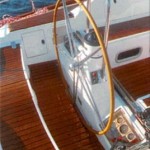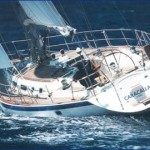While it’s true (and wise) that…
Not to be driven this way and that, but always to behave with justice and see things as they are.
~ Marcus Aurelius
…counsels a steady hand on the rudder of one’s life, it is equally important to know when to tack.
There’s a terrific bit of “life wisdom” you learn from sailing which goes as follows. But first you need the four rules for sailing:
- Keep the water out of the boat, lest you transition from sailing to swimming.
- The wind will try to set you in the direction it blows, just as the wind will push a tumbleweed.
- The water, (if there’s any current,) will try to make you drift in the direction it flows, just as the current will float you downstream when rafting on a river.
- One cannot sail directly towards the wind. There’s an arc of directions to either side of the direction from which the wind blows that are impossible.
The “trivial” exercise of operating the sailboat in various conditions is left for the reader.
Your challenge then is to get to your destination while following the rules. Interesting journeys will involve being near land, (beware Rule 1 because it’s the wet land that always gets you!) or cover long distances, (beware Rule 2 and 3 because their affects are cumulative and vary with time.) Interesting journeys will involve a specific destination which, thanks to unwritten Rule 5 are always to windward, so you cannot go directly there as per Rule 4.
…but you can go sort of towards it if you aim to the left of the wind’s source. And then you can tack, by turning quickly through the wind and going sort of towards your destination aiming to the right of the wind’s source. Doing so is called “tacking to windward.” Modern sailboats are pretty good at doing this. Ancient sailboats had to switch to rowing, or wait for different wind.
Finally, I can get to this part:
You’re going to be paying a lot of attention, sitting relatively still and watching the sailboat sail. You will also be paying attention to your destination which is almost certainly not directly in front of you. Untrained observers, (if they know your destination,) will be thinking, “why are you going in that direction?” Tacking isn’t very hard, but it slows you down and takes time and effort—you’d rather be sailing along, than tacking many times. (Perhaps at this point you’re thinking about geometry and those related-speeds word-problems you saw as a kid?)
While it’s true (and wise) that, “Not to be driven this way and that, but always to behave with justice and see things as they are.” counsels a steady hand on the rudder of one’s life, it is equally important to know when to tack.
ɕ
















